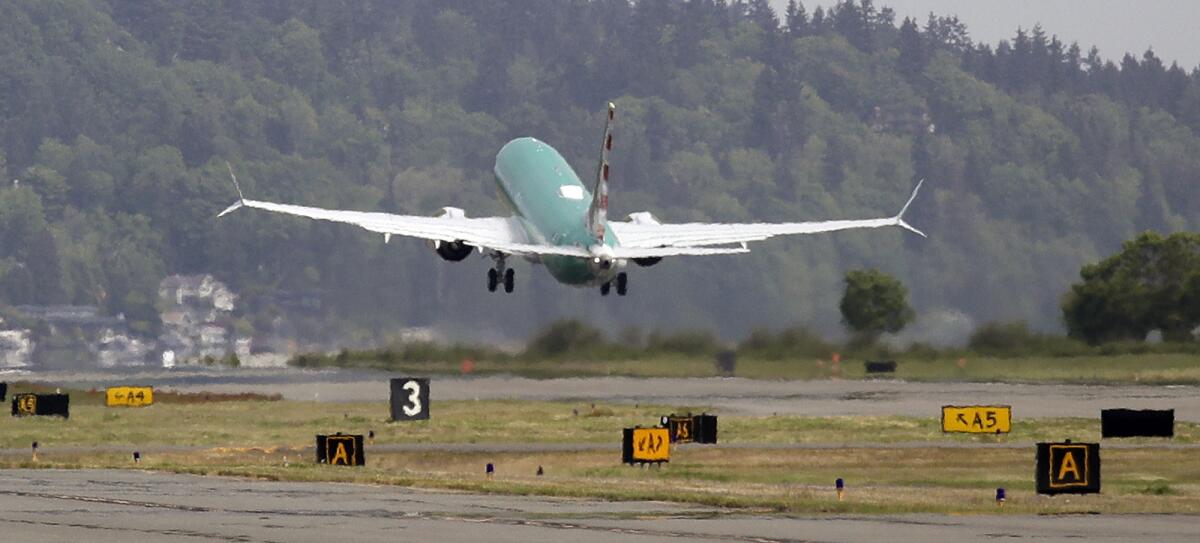Group finds aircraft approval process safe, despite Boeing 737 Max crashes

- Share via
A government committee asked to review U.S. approval of new passenger planes after two deadly crashes involving the Boeing 737 Max has found that the system is safe and effective but could be improved.
The committee differed sharply with legislators who are investigating Boeing Co. and the Federal Aviation Administration, which approved the Max. Key lawmakers have said they may try to stop the FAA from letting Boeing do some inspections and safety analysis on its own planes.
Thursday’s report came from a committee appointed by Transportation Secretary Elaine Chao in April, after crashes in Indonesia and Ethiopia killed everyone aboard each plane — a total of 346 people — and led regulators to ground Max jets worldwide.
The committee said the FAA’s system of delegating some safety work to aircraft manufacturers is effective and helps the U.S. aerospace industry thrive.
Lee Moak, a former airline pilot and union leader who co-chaired the committee, said members did not look at internal communications in which Boeing employees raised safety alarms about the Max while it was being developed and admitted to misleading regulators.
“It was not the purview of, or charter of, the committee to look at or investigate email traffic,” he told reporters.
In some of the Boeing employee messages, test pilots and other unnamed workers questioned the safety of the Max, called the plane a “joke” and talked about concealing problems from regulators.
Last week, leaders of the House Transportation Committee cited those messages and accused Boeing of deceiving regulators. Chairman Peter A. DeFazio (D-Ore.) and Rep. Rick Larsen (D-Wash.) said they will introduce legislation to strip the company of all or part of its authority to help approve its own aircraft as safe to fly.
Yet the special committee to review the FAA’s certification process wrote that the agency’s system of delegating work to aircraft manufacturers is “rigorous, robust and overseen by engineers, inspectors, test pilots and managers committed to the primacy of safety.”
The committee wrote that it didn’t do an investigation, but took a collaborative approach. Its mission was “to collect and analyze information, not find fault.”
Asked about possible mistakes in approving the Max, Moak said that was for other groups to investigate.
The committee recommended that the system of delegating inspections to manufacturers should continue, and that the FAA and industry should work together to address concerns about “potential undue pressure” on company employees designated to do inspections as planes go through the approval process.
However, Moak said the committee found no evidence of pressure on Boeing employees. It also found no reason to dramatically change delegation of inspections.
“We believe that delegated authority in itself enhances aviation safety as long as it is coupled with proper oversight and with safety management systems,” he said, referring to systems in which aviation employees voluntarily report safety concerns without fear of reprisal.
Initially the FAA determined that 35 of 93 elements of the Max could be delegated to Boeing employees, with 58 supervised by the FAA, the report said. But the ratio of delegated tasks changed through the years “as the FAA’s confidence in the aircraft design and related risk analyses evolved, including Boeing’s ability to manage such elements.”
The committee wrote that U.S. commercial aviation is a model of safety and innovation. The U.S. air carrier fatality rate has dropped to 0.6 per 100 million in fiscal year 2019 from 80.9 per 100 million passengers in 1996, the report said.
The report said aviation experts interviewed by the committee agreed that the FAA’s decision to certify the Max as an update to previous generations of 737s, rather than as a new type of aircraft, didn’t affect the Max’s safety. Treating the Max as a new aircraft “would not have produced a safer airplane,” the committee wrote.
Investigators have implicated new automated flight control software called MCAS as a factor in the crashes. In each crash, a single faulty sensor caused the system to activate and push down the nose of the plane. Boeing did not tell pilots about MCAS until after the Indonesian Lion Air crash, and regulators at the FAA didn’t know much about it.
In October, a panel of international aviation regulators found that Boeing changed the design of MCAS, making it more powerful, without telling the FAA. The panel said that if FAA experts knew more about how the system worked, they probably would have seen that it could overpower pilots’ efforts to stop the nose-down pitch.
More to Read
Inside the business of entertainment
The Wide Shot brings you news, analysis and insights on everything from streaming wars to production — and what it all means for the future.
You may occasionally receive promotional content from the Los Angeles Times.










